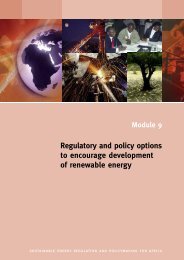Increasing access to energy services in rural areas - REEEP ...
Increasing access to energy services in rural areas - REEEP ...
Increasing access to energy services in rural areas - REEEP ...
You also want an ePaper? Increase the reach of your titles
YUMPU automatically turns print PDFs into web optimized ePapers that Google loves.
MODULE 10: INCREASING ACCESS TO ENERGY SERVICES IN RURAL AREAS<br />
page 10.85<br />
The orig<strong>in</strong>al idea that the ESCOs would be able <strong>to</strong> obta<strong>in</strong> the necessary start-up<br />
capital from commercial banks <strong>to</strong> procure their <strong>in</strong>itial PV systems was abandoned<br />
due <strong>to</strong> the high <strong>in</strong>terest on commercial loans which were around 40 per cent annually.<br />
These loan conditions would have made it impossible for the companies <strong>to</strong><br />
be profitable <strong>in</strong> the early stages of their development. To address this, the<br />
Government procured PV systems and loaned them <strong>to</strong> the ESCOs us<strong>in</strong>g grant funds<br />
obta<strong>in</strong>ed from Sida.<br />
2.2. Project Phase II<br />
Phase II of the project lasted from Oc<strong>to</strong>ber 2001 <strong>to</strong> December 2003 and was<br />
focused on establish<strong>in</strong>g the framework and conditions necessary <strong>to</strong> susta<strong>in</strong> the<br />
ESCOs and extend the project <strong>to</strong> other parts of Zambia. The most important component<br />
of this framework was the establishment of a fund<strong>in</strong>g facility <strong>to</strong> lend <strong>to</strong><br />
ESCOs on terms that would make them susta<strong>in</strong>able. The funds would be applied<br />
<strong>to</strong>wards expand<strong>in</strong>g exist<strong>in</strong>g ESCOs as well as establish<strong>in</strong>g new ones. Secondly the<br />
facility would also provide capacity build<strong>in</strong>g for the ESCOs <strong>in</strong> bus<strong>in</strong>ess management<br />
and PV technical skills.<br />
By the end of phase II, three ESCOs were operational with about 100 <strong>to</strong> 150 clients<br />
each. ESCOs cont<strong>in</strong>ued <strong>to</strong> receive tra<strong>in</strong><strong>in</strong>g. The issues regard<strong>in</strong>g loan repayment<br />
and transfer of ownership of the PV systems were discussed. Due <strong>to</strong> the low number<br />
of clients serviced by each ESCO, it was not possible for the ESCOs <strong>to</strong> generate<br />
sufficient profit and cash flow <strong>to</strong> repay the loans. Consequently the issue of<br />
ownership transfer rema<strong>in</strong>ed unresolved at the end of phase II.<br />
The objective of extend<strong>in</strong>g the project <strong>to</strong> other parts of Zambia could also not be<br />
achieved because the guidel<strong>in</strong>es for repayment of the old debts and availability<br />
of new credit rema<strong>in</strong>ed unresolved.<br />
2.3. Project Phase III<br />
Phase III of the project lasted from September 2004 <strong>to</strong> September 2005. The ma<strong>in</strong><br />
objective of phase III was <strong>to</strong> consolidate the experiences from the first two phases<br />
and develop the necessary framework <strong>to</strong> ensure long-term susta<strong>in</strong>ability of the<br />
PV-ESCOs concept. The follow<strong>in</strong>g were the ma<strong>in</strong> <strong>areas</strong> of focus:<br />
• Develop credit agreements between the MEWD and the ESCOs <strong>to</strong> provide for<br />
the repayment of start-up capital and the ownership transfer of the PV systems;










